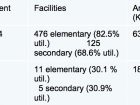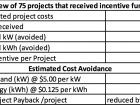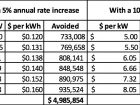
News
Managing energy for one of the largest asset portfolios in North America
January 27, 2016 - Hint... did your kids’ schools come to mind? One of the largest asset portfolios in North America isn’t made up of the shiny glass towers of corporate America or the glitter of retail malls. Instead it’s the network of schools that stretch across Ontario.
January 7, 2016 By Robert Smith CET CEM

With more than 5500 sites and over 250,000,000 sf, Ontario’s education sector is larger in size than several of Canada’s leading national property management companies’ portfolios combined!
Ontario’s education sector consists of 72 district school boards, grouped into four categories:
• Public
• Catholic
• English
• French
Each district school board is autonomous and makes its own decisions about policies and programs related to operations issues, such as energy management.
School boards receive 100% of their funding from the Ministry of Education. Funding allocations are announced each Spring for the subsequent school board fiscal year, which runs from September 1 to August 31. Boards receive a Plant Operations allocation, which covers expenditures related to maintenance, custodial supplies, salaries and utilities.
Overview of asset portfolio
Initially, it might appear that schools sound like a simple, straightforward asset portfolio. Many of us received an education in one or both of the two classic types of buildings—elementary schools (JK to Grade 8) and secondary schools (Grades 9 to 12)—but consider the following complexities of the portfolio that impacts energy management:
- The year of construction ranges from 1791 to present day.
- Site sizes range from as small as 750 sf to as large as 270,000 sf.
- The number of sites within a board’s portfolio can range from as few as nine to as many as 634.
- The geographic territory can be quite small and centralized in large, urban centres (e.g. the Greater Toronto Area) or can be a vast area with only a few schools scattered across it, and travel times of up to six hours between outlying sites (as is the case for many northern, rural or French boards).
- In addition to the standard K-12 schools, boards may also have administrative offices (Education Centres), outdoor education facilities, daycares, maintenance/warehouse facilities, and sites with joint ownership, such as a school that is owned by two school boards, or with a municipality (e.g. community centres, libraries, pools).
Table 1 (bottom): This chart demonstrates the differences that can exist between two school boards within Ontario. Source: Ministry of Education, 2014-15, Revised Estimates.
Additional energy management challenges
In addition to the diversity of the overall asset portfolio, Ontario’s education sector is undergoing a number of transitions that will have an impact on energy consumption:
• Since Fiscal Year 2002-03, student enrolment has been declining across the province. In some northern communities, declining enrolment has reached as high as 15%.
- Utilization of some sites can be as low as only 29.1%.
- Funding allocations for boards are based on student enrolment, which means administrative funding has also been declining.
• Energy management and operational capacity across the province is inconsistent.
- Boards with larger budgets have greater flexibility to be able to hire a dedicated resource—an expert in energy management that can focus on reducing energy consumption. In contrast, energy management within a small board would likely be combined with a series of other functions, such as maintenance, student transportation, custodial management, snow removal, etc., and, as a result, the individual may not have a high level of knowledge or expertise in energy management.
• Over the next few years, Human Resources analysis indicates there will be a significant departure of key management and operational personnel across all school boards as baby boomers reach retirement age.
- A substantial amount of corporate knowledge and understanding of how to effectively manage and operate facilities will leave the sector.
• Economies of scale exist for larger boards, such as:
- Depth of expertise in energy management.
- Lower per-unit costs resulting from volume procurement (buying 1000 versus 200,000 replacement lamps).
- Leveraging procurement processes to cover multiple sites (new roof for five sites in a year); the ability to write one RFP for multiple projects.
• Increased hours of operations
- Schools are no longer a 9 to 3:30 business; with daycare, after-school programs, community use and continuing education programs, schools can open as early as 6:00 am and remain in use up until 10:00 pm.
- As more constraints are placed on funding across the entire public sector, municipalities are looking to use local schools and their infrastructure as community hubs to provide programs both during the week and on weekends, further expanding the traditional hours of operation.
• Across the province, school boards have relationships with 68 electricity local distribution companies (LDCs) and four natural gas LDCs.
- Many boards, especially those with large territories, have relationships with multiple LDCs—in some cases, as many as 12 electricity LDCs for one board.
The Ministry of Education cares about energy management
The Ministry of Education has four renewed goals:
- Achieve Excellence: Children and students of all ages will achieve high levels of academic performance, acquire valuable skills and demonstrate good citizenship. Educators will be supported in learning continuously, and will be recognized as among the best in the world.
- Ensure Equity: All children and students will be inspired to reach their full potential, with access to rich learning experiences that begin at birth and continue into adulthood.
- Promote Well-Being: All children and students will develop enhanced mental and physical health, a positive sense of self and belonging, and the skills to make positive choices.
- Enhance Public Confidence: Ontarians will continue to have confidence in a publicly funded education system that helps develop new generations of confident, capable and caring citizens.
So what do any of these four goals have to do with energy management?
In a nutshell, it is believed that there is a direct correlation between how a school board is managed and student achievement; the better managed the board, the higher the levels of student achievement.
Acting on this premise, the Ministry initiated Operational Reviews of all school boards beginning in 2007. The purpose of these reviews was to examine all functional areas of governance, administration, management and operations against leading business practices in a board. At the conclusion of each Operational Review, the board received a report outlining the findings and identifying opportunities for improvement.
In the early stages of the Operational Reviews, energy management was identified as an area that was either weak or non-existent for many boards.
The Ministry of Education’s Energy Management Initiative
Given the complexity and diversity of the asset portfolio, the unique challenges related to geography and structure, the large number of decision-makers and their varied level of knowledge/expertise, any strategy to build energy management capacity across the education sector needed to be multi-faceted to address both the distinct challenges and varying capacity of front-line staff.
Fortunately, the Ministry and its 72 school boards have a collaborative relationship and a long history of partnering to find ways to improve and build on identified successes across the sector. Through this partnership, the Ministry identified the cornerstones that were required by the sector: information, resources and tools.
In 2008, the Ministry launched its Energy Management Initiative, and here’s what they did:
Energy Conservation Officer (ECO)
The challenges
1. To give the Energy Management Initiative credibility within the education sector as a whole but, specifically, with senior plant managers or energy managers.
2. Within the sector, there were individuals with expertise in energy management, but there wasn’t a formal structure for sharing that knowledge or nurturing it within boards that lacked that expertise.
Starting point
The Ministry needed an “energy management champion” to lead the initiative; someone who had:
• recognized credentials and a technical background in energy management,
• knowledge and experience of education facilities, and how the sector worked,
• a track record of consistently reducing energy consumption across a board’s asset portfolio over an extended period, and
• credibility within the education sector as a leader in energy management.
The role of the ECO is to:
• provide interested school boards with technical support and advice in energy management,
• lead and manage specific energy initiatives, such as the Incentive Programs Advisor,
• provide the Ministry with advice on how to implement specific energy projects in the education sector, and
• work with energy managers across the sector to identify best practices in energy management within the sector and to promote them.
Solution
Norm Vezina, Senior Manager of Environmental and Office Services, York Catholic District School Board (YCDSB), was appointed as the ECO for the sector. Over a decade, Vezina had reduced YCDSB’s energy consumption by 44%. In addition, he was the lead for the Catholic School Board Services Association’s (CSBSA) Electricity and Natural Gas Procurement Consortia, and he was well-known and respected by his peers across the sector.
Results
• Interested boards now have a key contact person with relevant knowledge and experience to ask specific questions about energy management.
• Specific energy initiatives were tailored to meet the sector’s needs because they had a spokesperson who represented their perspective, and was key in developing each project from concept through implementation stage.
• Each energy management project was built to work in conjunction with the other existing or planned projects that were being done by both the Ministry and other sector organizations so as to maximize their effectiveness.
• Acting as Chair of the Operations, Maintenance and Construction (OMC) Energy Subcommittee, the ECO asked boards to share their best practices in energy management, and these were promoted to all boards.
Utility Consumption Database (UCD)
The challenges
1. The underlying premise of conservation is that you can’t conserve what you can’t measure, and only a handful of boards had the tools in place to measure energy consumption.
2. For energy consumption data to have meaning, it has to be done at the site level, by utility, and include factors that impact a site’s energy consumption, such as building area. Furthermore, data had to be collected over an extended period and allow for weather normalization so that year-over-year comparisons could be made to assess the effectiveness of specific energy management strategies.
3. In 2006, the Ministry of Energy passed the Energy Conservation and Leadership Act, which proposed creating regulations that would require all Broader Public Sector (BPS) organizations to report on their energy consumption. In 2009, the Green Energy Act replaced the existing legislation and, in 2011, regulations came into force requiring all BPS organizations to submit an Annual Energy Consumption and Greenhouse Gas Emissions Report to the Ministry of Energy detailing the energy consumption by type for each site.
Starting point
In 2008, the vast majority of school boards did not measure energy consumption at all (neither site nor board levels). A few boards had stand-alone systems that collected data, but those systems collected data for a small number of sites for a single board (typically through a manual process pulled from billing statements).
For most boards, the only means of measuring energy was via utility costs, which was ineffective due to price volatility, and inappropriate as it did not allow for either meaningful comparisons (e.g. year-over-year, similar sites) nor the ability to meet regulatory reporting requirements.
Solution
The Ministry of Education created a tool for all school boards that would track the historic energy consumption of every site across the sector: the Utility Consumption Database (UCD). Its goal was to create an analytical tool that would give every school board and the Ministry the ability to:
• Review energy consumption by type for an individual site, a board’s aggregate total, a regional aggregate total or provincial aggregate total.
• Compare the energy consumption of sites with similar features (e.g. year of construction, building area, number of portables, hours of operation, percentage of air-conditioned area) both within a board and across the sector to allow for benchmarking.
• Compare energy consumption for an individual site, an entire board’s asset portfolio or the entire sector’s asset portfolio from one year to another without skewing for weather variations (weather normalized data).
• Identify trends in energy consumption i.e. high-performing sites, low-performing sites, overall reduction in energy consumed, etc.
• Meet the regulatory reporting requirements of the Green Energy Act.
Given the size of the project—more than 5500 sites—the Ministry made the decision to limit the data collection at the time of launch to two utilities: electricity and natural gas. This decision was based on the following key factors:
1. Electricity and natural gas are the only utilities required by regulation to provide consumption data to customers in an electronic format.
2. Based on total Utility Expenditures in FY2006-07, electricity and natural gas costs represent almost 98% of total utility costs (N.B. when the decision to create the UCD was made in 2008, FY2006-07 data were the latest figures available).
In 2015, the UCD expanded to collect data on Alternative Utilities (e.g. heating fuel, propane, wood, district heat/cool), renewable energy (e.g. solar PV, solar air, solar water, wind turbines, biomass) and water.
Results
In 2009, the Ministry launched the UCD. It is currently one of the largest databases of its kind in North America with:
• 5483 sites
• 7235 electricity meters
• 5765 natural gas meters
The UCD is remarkable… not just for the quantity or quality of the data, but the number of participants involved in the process—specifically, 72 school boards and the 68 electricity LDCs and four natural gas LDCs that provide the UCD with electronic consumption data.
In 2013—the first year of the Green Energy Act’s Annual Energy Consumption and Greenhouse Gas Emissions report was due—school boards were able to use the UCD to automatically pre-populate the reporting template, which significantly reduced the quantity of administrative work required to complete the report. As a result, the education sector has had the highest level of reporting compliance across the entire Broader Public Sector (BPS) for the past three consecutive years.
Incentive Programs Advisor
The challenges
School boards had difficulty accessing incentive program funding for the following reasons:
• More than 40 energy efficiency incentive programs existed, and there was confusion about which programs were applicable.
• Various incentive funding and delivery agents and rules.
• Numerous documentation requirements.
• Lengthy approval processes
Starting point
Because of all the perceived challenges, many school boards were simply opting not to apply for incentive funding. As a result, there wasn’t a financial reason to make better long-term choices, or they were implementing energy-efficient equipment and losing out on a valuable opportunity to leverage additional public funding to support its implementation.
Solution
The Ministry identified the need to make the application process to incentive funding programs easier. What was needed was a sector-wide resource that was an expert at completing incentive applications and dedicated to assisting school boards with the process.
Through a partnership between the Ministry and YCDSB, the ECO applied to the Ontario Power Authority (OPA) for a Conservation Fund Grant to pilot the creation of an Incentive Programs Advisor (IPA). The IPA pilot ran from 2009 to 2011 with matching Ministry of Education and OPA funding. At the conclusion of the pilot in 2011, the Ministry of Education took over sole funding for the IPA position. (Note: OPA was merged in with Ontario’s Independent Electricity System Operator [IESO] effective January 1, 2015.)
Available to all interested school boards at no cost, the role of the IPA is to:
- Provide information and advice on energy incentive programs (e.g. federal/provincial, electricity/natural gas) to interested school boards.
- Liaise with senior plant officials to identify appropriate incentive programs for specific schools.
- Assist individual boards in completing applications for government, utility or agency energy-incentive funding.
- Document best practices/lessons learned about incentive programs and promote them to the sector.
- Identify existing barriers to boards accessing incentive programs.
- Develop strategies to maximize the number of schools that participate in incentive programs to ensure boards access as many as possible.
Results
Since 2009, the IPA has completed more than 600 incentive funding applications on behalf of school boards. The total value of the applications is over $7 million. To date, school boards have received over $5 million in incentive funding, with another $2 million in process or pending approval.
In 2013, the Ministry reviewed the impact of incentives in the sector and found that there were both immediate and long-term savings/cost avoidance through:
• Reduced payback period
• Decrease in demand (cost avoidance)
• Decrease in energy used (cost avoidance)
Table 2: In 2013, a review of 75 projects that received incentive funding showed the associated immediate and short-term savings/cost avoidance.
Table 3: Calculations of the long-term cost avoidance associated with the 75 projects that received incentive funding with an annual increase of either 5 or 10%.
One of the unintended results of creating the IPA position is that the OPA recognized this position as a “super user”—that is, the IPA’s volume of incentive applications was so high, it reflected a level of expertise with incentive programs that could be tapped by funding agents to determine better ways of helping the education sector participate in specific incentive programs, and to identify ways of tailoring programs to make them work.
For example, the goal of many incentive funding agents is to reduce peak demand on the province’s electrical system, yet schools—by the nature of their business—cannot shift their consumption patterns outside the primary hours of operation, which left some incentive programs irrelevant to the sector.
Another sector-specific challenge for incentive programs is the requirement for pre-approval of applications before work can begin. As everyone knows, schools run on a non-negotiable schedule: students occupy the buildings from September to June (and sometimes July and August for summer school and other activities), leaving very little opportunity to complete major projects. However, the approval process for some incentives can be quite lengthy—on average, about 50 calendar days. The result in many cases is that boards have applied for an incentive program but have not received the pre-approval to proceed with the implementation of the equipment by the scheduled start date, forcing them to implement the project without it.
Gradually the OPA and LDCs are beginning to improve the approval process. An example is the recent change to the Unitary AC program that now allows a 45-day retroactive period for unplanned equipment replacements.
Summary
The education sector’s Energy Management Initiative has been built around three key cornerstones:
• Information: Energy Conservation Officer
• Resources: Incentive Programs Advisor
• Tools: Utility Consumption Database
Together the Ministry and the education sector have laid the foundation for building energy management capacity across Ontario. ◊
— An incentive programs advisor, Robert Smith, CET, possesses over 35 years of experience in the energy sector. He is a Certified Engineering Technician and successfully completed Certified Energy Manager training. He currently works with Ontario’s Ministry of Education helping all 72 school boards access incentive programs to help fund their energy conservation projects. Robert has completed over 429 incentive applications, and has been successful in helping school boards secure over $5.1 million in incentive funds since 2009.
— Photo courtesy Ontario Power Authority, which merged with IESO (Independent Electricity System Operator) January 2015
Print this page




